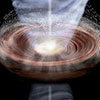| Dec 14, 2021 |
|
|
|
(Nanowerk News) The world’s first 3D simulation simultaneously considering dust motion and growth in a disk around a young star has shown that large dust from the central region can be entrained by and then ejected by gas outflows, and eventually fall back onto the outer regions of the disk where it may enable planetesimal formation.
|
|
This process can be likened to volcanic “ashfall” where ash carried up by gas during an eruption falls back on the area around the volcano. These results help to explain observed dust structures around young protostars.
|
 |
| Artist’s impression of the “Ashfall” in a protoplanetary disk. The dust particles swept up by the bipolar outflow from the center of the protoplanetary disk are piled up on the outer edge of the disk. (Image: Kagoshima University)
|
|
Observations by ALMA (Atacama Large Millimeter/submillimeter Array) have revealed gaps in protoplanetary disks of gas and dust around young stars. The gravitational effects of planets are thought to be one of the reasons for the formation of these rings.
|
|
However, some rings are seen even further out than the position of Neptune in the Solar System. At these distances, dust, a vital component to planet formation, should be scarce.
|
|
Furthermore, the dust is expected to move in towards the central region of the disk as it grows. So how planets can form in the outer regions has been a mystery.
|
|
A research team led by Yusuke Tsukamoto at Kagoshima University used ATERUI II, the world’s most powerful supercomputer dedicated to astronomy calculations at the National Astronomical Observatory of Japan, to perform the world’s first 3D simulation of dust motion and growth in a protoplanetary disk (Astrophysical Journal Letters, “Ashfall” Induced by Molecular Outflow in Protostar Evolution”).
|
|
The team found that large dust particles grown in the central region can be carried out perpendicular to the disk by streams of gas, called bipolar outflow, erupting out from the disk. This dust then drifts out from the outflow and gravity pulls it back down to the outer part of the disk. Tsukamoto comments, “Living in Kagoshima, in the shadow of the active volcano Mt. Sakurajima, I naturally thought of volcanic ashfall when I saw the simulation results.”
|
|
The simulation shows that this “stellar ashfall” can enrich large dust in the outer region of the protoplanetary disk and facilitate planetesimal formation, which may eventually cause planet formation.
|


